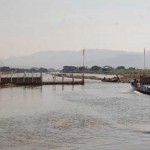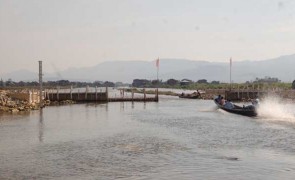 Inle Lake in Myanmar, the only lake in this planet where you can find the leg rowers, has been a major tourist attraction in the region for many years. You can ride a boat along the lake and watch the leg rowers with their oddly-designed fishing net on their boat. If you are lucky, you can even enjoy the leg rower’s boat race, at your request. However, unfortunately, the magnificent Inle Lake is in big danger now. Water of the lake is getting scarcer, shrinking the lake area which has become narrower than ever. Without any preservation done, the magnificentInleLakecan be disappeared in near future.
Inle Lake in Myanmar, the only lake in this planet where you can find the leg rowers, has been a major tourist attraction in the region for many years. You can ride a boat along the lake and watch the leg rowers with their oddly-designed fishing net on their boat. If you are lucky, you can even enjoy the leg rower’s boat race, at your request. However, unfortunately, the magnificent Inle Lake is in big danger now. Water of the lake is getting scarcer, shrinking the lake area which has become narrower than ever. Without any preservation done, the magnificentInleLakecan be disappeared in near future.
“As you all know, lake area of Inle lake in Myanmar is getting narrower, and water quality is getting worse. Previous years, even though it is not clean enough to drink, we can still use it for general purpose. But now, from health view point it is not even good to use anymore. Some of the residences still have to use the water from this lake as there are no other sources, it can affect the health of the residences either directly or indirectly. Local people should take note of this.” told by one of the nature preservation specialists.
In fact, the local people are one of the culprits in spoiling the water quality by overusing insecticides and chemical fertilizers. Water hyacinth and weeds are also overgrown in the lake, and some abandoned floating gardens need to be tidied up in a correct manner. Worst of all are the wastes from restaurants and hotels which are drained directly into the lake while cesspits are not formed properly. Used coloring dye from local loom businesses is also being dispensed into the lake.
“Some local people are still practising nature un-friendly business but you cannot blame them as they also need to earn a proper living. Some overuse insecticides, especially in tomato fields; a lot of chemical fertilizers can be found in tomato fields. Some people dispose rubbish into the lake without any discipline. Those are the factors diminishing the water quality. From the viewpoint of health, people utilizing water from this lake for drinking is really a health hazard to them.” told by one of the UNDP staff.
Due to 1934’s land surveying map, lake area was 104 square miles, in 2005 it became 87.54 square miles, and in 2007 it was only 67 square miles; depicting a dramatic change confirmed byShanStategovernment land surveying department. 29 rivers are flowing into Inle Lakea in Myanmar and drainage area is 1422 square miles in total.




